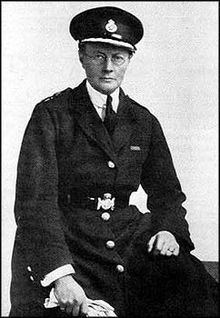Name Margaret Dawson | Died 1920 | |
 | ||
Margaret Damer Dawson & The Women’s Police Service
Margaret Mary Damer Dawson OBE (1873–1920) was a prominent anti-vivisectionist and philanthropist who co-founded the first British women's police service.
Contents
- Margaret Damer Dawson The Womens Police Service
- Life
- Women Police Volunteers
- Womens Police Service
- Legacy
- References
Life
Dawson was born on 12 June 1873 to a rich family in Hove. Her father died and her mother remarried to become Lady Walsingham. Her step-father was Thomas de Grey, 6th Baron Walsingham. Margaret had a private income. She studied music with the Austrian pianist Benno Schoenberger at the London Academy of Music. Dawson got involved in anti-vivisection and other good causes and she founded a home for foundlings. She was awarded silver medals by Finland and Denmark for her campaigning work for animal rights. Margaret was Honorary Secretary of the International Anti-Vivisection Council set up in 1908 by Lizzy Lind af Hageby, and they organized between them the International Anti-Vivisection and Animal Protection Congress in London in July 1909. As Honorary Organizing Secretary of the Animal Defence and Anti-Vivisection Society. This organisation campaigned against obvious cruelty and the socially acceptable circus performing animals and the slaughter of animals for meat.
Women Police Volunteers
Before the first World War it had been proposed by those interested in women's rights that there should be female as well as male Police officers. The war prevented any progress but a volunteer service was established by Damer Dawson and Nina Boyle. They had met when Damer Dawson was working for the Criminal Law Amendment Committee in 1914. They joined forces after seeing the trouble faced by refugees during the war. It was Nina Boyle who led the organisation with Dawson as assistant. Damer Dawson had been made aware that Belgian women were being recruited as prostitutes when they arrived at British railway stations. These volunteer women were allowed to officially patrol the streets of London and policemen were asked to assist them. These "Women Police Volunteers" were trained and they were intended to assist women during the turmoil of the war.
Women's Police Service
Boyle was of the view that the new organisation should assist in catching criminals, whereas the role that was being created for the force was to enforce the Defence of the Realm Act and to supervise female workers and public decency. Damer Dawson and Boyle parted over a problem in Grantham when the women police were asked to enforce a curfew on women to protect the men from the temptations of prostitutes. In August 1915, Edith Smith was appointed the first woman police constable in England with full power of arrest.
Boyle saw the use of policewomen to impose a curfew on women as against her beliefs. Damer Dawson took a more pragmatic line. Boyle asked for Dawson's resignation, but instead Dawson convened a meeting of fifty policewomen and 48 of them agreed to follow Dawson's ideas. Damer Dawson was soon leading a renamed Women's Police Service. Like similar groups the WPS was disbanded at the end of the war but it was the first uniformed women's police service and it continued to operate. Dawson's request to have her volunteers made into police officers was refused as the police Commissioner felt that it was cause friction because the women were too well educated. Dawson and Allen were both awarded an Order of the British Empire in 1918. Edith Smith left the service and died of an overdose in 1924.
Damer Dawson was asked to help with advising on a national view when the Baird Commission looked at the role women in policing. She and any of her followers had been specifically excluded from being on the Baird Commission on the advice of the Police Commissioner who disliked lesbians and in particular Dawson. Damer Dawson thought that the police force for women should be entirely separate from the male service. This view did not prevail and Dawson died prematurely of a heart attack in 1920. Her leadership role was taken over by Mary Allen. Allen had been Damer Dawson's assistant for many years and they had lived together during the first World War having both a close professional and personal relationship. Dawson died on the 18 May 1920 and left her house and most of her money to Allen.
Legacy
Damer Dawson was buried in Lympne on 22 May 1920 after a funeral attended by other women Police ooficers. A memorial was erected in the corner of Lymne churchyard to her. Dawson's finances showed that she was no longer rich and she had spent money on the voluntary police service. Her home that she shared with Mary was left to her.
Damer Dawson's house at 10 Cheyne Walk has a plaque to commemorate Dawson. There was also a bird bath installed in Cheyne Walk. It was organised by Miss St John Partridge and designed by Charles Pibworth The bird bath has been restored and it incorporates a quote from Rime of the Ancient Mariner " 'He prayeth best who lovest best all things great and small'.
The home for babies that Dawson helped found was funded by the Women's Police Service's benevolent service in Kent. After Dawson's death it was renamed the "Damer Dawson Memorial Home for Babies".
